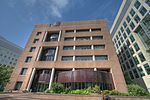Moderna

Moderna, Inc., ( mə-DUR-nə) is an American pharmaceutical and biotechnology company based in Cambridge, Massachusetts that focuses on RNA therapeutics, primarily mRNA vaccines. These vaccines use a copy of a molecule called messenger RNA (mRNA) to produce an immune response.The company's only commercial product is the Moderna COVID-19 vaccine. As of 2022, the company has 44 treatment and vaccine candidates, of which 21 have entered clinical trials. Targets for vaccine candidates include influenza, HIV, respiratory syncytial virus, Epstein–Barr virus, the Nipah virus, chikungunya, a combined single-shot COVID-19 booster and influenza vaccine, a cytomegalovirus vaccine, and two cancer vaccines. The company's pipeline also includes candidates for cancer immunotherapy using OX40 ligand, interleukin 23, IL36G, and interleukin 12 as well as, in partnership with AstraZeneca, a regenerative medicine treatment that encodes vascular endothelial growth factor A to stimulate blood vessel growth for patients with myocardial ischemia.
Excerpt from the Wikipedia article Moderna (License: CC BY-SA 3.0, Authors, Images).Moderna
Technology Square, Cambridge Cambridgeport
Geographical coordinates (GPS) Address Nearby Places Show on map
Geographical coordinates (GPS)
| Latitude | Longitude |
|---|---|
| N 42.3633 ° | E -71.091 ° |
Address
200 Technology Square
Technology Square 200
02238 Cambridge, Cambridgeport
Massachusetts, United States
Open on Google Maps








